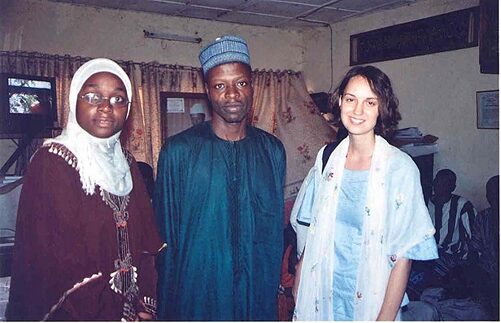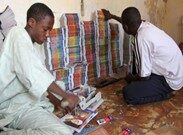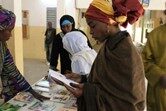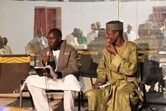What motivated you to do research on literature and cinema of the Hausa language?
When I first started the PhD programme in the Department of African Languages and Literature at the University of Wisconsin in Madison (USA), I was planning to write about English-language literature. I had never really heard much about Hausa literature until 2005 when I went to Sokoto, Northern Nigeria, to work on my Hausa language skills, which were a requirement of my programme. However, my teacher Malami Buba had me begin to read novels, and I also began to take trips to the local film club to rent Hausa movies. The reading felt like homework until I began to read Ado Ahmad Gidan Dabino’s novel “In da So da Kauna” (When with love and affection), which tells the story of star-crossed lovers: a rich girl and a poor boy. A wealthy man bribes the girl’s grandmother to pressure her parents into marrying her to him. I began to read eagerly and quickly like I had read science fiction in high school. That is really the novel that made me fall in love with Hausa literature.
I was also enamoured of the singing and dancing in the Hausa films and the young people telling stories of ordinary life in northern Nigeria. There were plenty of scholars who had written about Hausa literature and film, including my teacher Malami Buba, Graham Furniss, Novian Whitsitt, Brian Larkin, and most notably Bayero University scholars Abdalla Uba Adamu and Yusuf Adamu, but this was the first time I had ever realized it existed. I wondered why the writers I knew in the city of Jos, who were involved with the Association of Nigerian Authors, had never talked about Hausa literature. So, I realized that this would be a more important area to study than English-language literature, which is accessible to scholars anywhere.
I have always been fascinated by literary movements where writers and artists and musicians all influence each other. I felt like this was one of those movements here and now in northern Nigeria. More than wanting to study it, I wanted to just go and be a part of it. So, I was able to get a research grant to go to Kano in 2006. My PhD research ended up focusing on the film industry and censorship crisis that occurred from 2007-2011 during my time in Kano. I spent a lot of time in film editing studios and on sets and was even able to act in a few minor roles in films, which I thoroughly enjoyed!
How has the writing and reading culture developed in Northern Nigeria?
There has been writing and reading going on in what is now northern Nigeria from probably around the 11th or 12th centuries. Much of the early writing was in Arabic, but Hausa-writing in Ajami (the Arabic script used to write non-Arabic languages) has been documented since at least the 1600s. The religious and political reformer Usman dan Fodio was a renowned scholar, and his whole family was involved in scholarship, translation, and teaching, including, most famously, his daughter Nana Asma’u. When the British colonial government adopted Hausa as an administrative language, they decided to use the roman script rather than Ajami. So, they held a writing contest in the 1930s with the intention of picking the best submissions for publication to provide reading materials in the roman script. Some of the most well-known early Hausa language novelists emerged out of that contest: Abubakar Imam, who also became the editor of the Hausa language newspaper “Gaskiya Ta fi Kwabo”, and even Sir Abubakar Tafawa Balewa, the first prime minister of Nigeria, who wrote a novel “Shaihu Umar” about slavery in the Sahel. Writing continued in this tradition for about sixty years and was mostly published by government publishers for use in school.
In the 1980s, there was a mass public of young people who had been educated to read and write in roman script. Although the structural adjustment programmes of the 1980s disabled the publishing companies, the newly available personal computer made it easier for people to self-publish a professional looking product. While the novels have often been described as “pamphlets” or chapbooks, this is usually only because they are published serially, mostly from two to five parts. This allows writers to publish quickly and cheaply and makes them affordable for young people. Ado Ahmad Gidan Dabino and Balaraba Ramat Yakubu were early popular writers, who were involved in the group Raina Kama. Dabino now owns a publishing house and provides editing services. Writers will pay for the books to be printed, but he will not put his name as publisher on the book unless he feels it is of a certain quality.
There are now hundreds of writers, thousands of novels, and probably millions of readers in northern Nigeria, Niger Republic and the surrounding regions. Although the novels have been called “littattafan soyayya,” novels of love, there has actually been a little bit too much focus on the “romance” aspect. The novels range from family drama, social critique, to detective novels, political thrillers and fantasy adventure. There has also been a media focus on the literature as if it is exclusively written by women, but it is a literary movement that includes both men and women, although women do tend to prefer reading fiction by other women. I see readers everywhere: in taxis, at weddings, in homes, in studios, on film sets. There are book rental clubs, and the novels are often read over the radio, serialized in newspapers, or also adapted into film. There is this clichéd complaint among the educated class in Nigeria that there “is no reading culture.” This is nonsense even in English, but there is no way you can talk about a “lack of reading culture” among the Hausa.
Hausa novels and films
The Hausa novels and films grew up together intertwined. Actors in drama groups became novelists and later also became directors, producers, and scriptwriters. And filmmakers often adapt Hausa novels into film. So, in this way there is a much tighter and more organic connection between the popular literary movement and the film industry than you see in the English-language Nollywood. Ibrahim Birniwa, for example, is a popular novelist who has written blockbuster movies.
Nazir Adam Salih is another writer who writes popular film scripts. Although there are fewer women writers who are directly involved with the film industry, some of them like Balaraba Ramat Yakubu have become producers and scriptwriters. Balaraba Ramat Yakubu, who has written seven novels; is planning to begin shooting a TV series of her two part novel “Wa Zai Auri Jahila?” that tells the story of a girl married at 12 to an old man of 50, how she runs away from her marriage, becomes educated, and lives a more fulfilled and independent life.
What would you respond to the general opinion of critics that the Hausa novels and films are Western stereotypes, that they are based on Indian movies, expose audiences to corrupting global influences and misrepresent Hausa culture?
A common critique
This is a common critique. Certainly there is Western and Indian influence on the novels, but I would say that it more reflects how those influences are felt in daily life. Indian films have been a constant part of northern Nigerian life for around fifty years now. People have “Indian nights” at their weddings, they import saris and bindis and shalwar kameezes. People attend schools where they learn English, and they watch American movies and music videos.
The novels and films creatively incorporate those influences into storylines that reflect Hausa society as it is lived. Certainly, some of the storylines are contrived or unrealistic and sensational. But popular culture all over the world includes such. And many of the novelists claim to write about things that have happened to them or that they have observed. So, I think sometimes this “Indian influence” is overstated. The publicity around “Sin is a Puppy that Follows You Home” the recently translated novel by Balaraba Ramat Yakubu, for example, claims that it is a Bollywood influenced romance novel. But I see much less Indian-influence there than in other novels, and it is less romance novel than social critique. The Hausa researcher Brian Larkin points out that people see similarities in Indian films to the modes of dressing, food, and customs of Hausa culture. So, it is often more of a recognition of parallels between both cultures than a conscious imitation.
How would you describe the approach of the Hausa writer nowadays towards a conservative society and the terrorist group Boko Haram, as well as the fast social changes in Northern Nigeria?
This is a bit of a sensitive issue. My current research project is to look at the way novels and films reflect Boko Haram, but when asking these questions one has to be a bit careful. People are rightly concerned about Boko Haram and they wouldn’t want to be attacked for writing about them. Remember, though, that Boko Haram is still a fairly recent phenomenon and that people have been writing novels in Hausa for decades before they came on scene. Some of the novels would try to negotiate how to live peacefully in a conservative society, others push boundaries and challenge social norms, while still others “warn” people against the excesses of modern life but do so in ways that conservative critics sometimes see as threatening. In my interviews with writers, many of them say that a major goal is to “teach” certain lessons. But as Nazir Adam Salih, a really fantastic thriller writer, told me, if you preach too much to people they won’t want to read your novel, so you have to hide any moral lessons in an entertaining story. He does a very good job at that.



